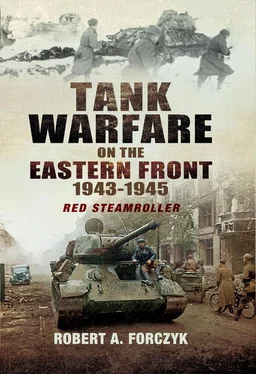On 1 March, the Soviet 59th Army began a major offensive from the Krivasso bridgehead which created a substantial lodgement south of Narva. However, the Nordland division finally destroyed the small bridgeheads north of Narva, which allowed the Germans to shift the Feldherrnhalle division to block this southern threat. On 6 March, the Soviets heavily bombed Narva, turning it into a pile of rubble, then attacked across the river with 2nd Shock Army. On 17 March, the 59th Army attacked from the south to sever the main east-west rail line, but three Tigers under Carius managed to hold the thinly-manned HKL and destroyed 14 T-34s and 1 KV-1, which halted the attack. {5} Instead of overwhelming Carius’ small force, the Soviets attacked piecemeal, with only company-size groups of tanks supporting a battalion of infantry. Despite heavy casualties, the German defence held and after two weeks of heavy fighting the Soviets ceased their attacks.
As the Soviet offensive ebbed, the OKH decided to mount a major counter-attack to try and eliminate the 59th Army’s Krivasso bridgehead. It was a decidedly low-budget affair. Oberst Graf von Strachwitz was sent to Narva to lead a Panzerkampfgruppe formed from the remaining Tigers and a handful of Panthers and Pz IVs scraped up from repair depots. Elements of three infantry divisions were also committed to the effort. On 26 March, Strachwitz attacked and in six days he managed to demolish the western side of the Soviet bridgehead. The 59th Army had not expected a tank attack and failed to establish effective anti-tank defences. Strachwitz resumed the counter-offensive in early April and achieved more success until the spring thaw brought a halt to his mobile operations. The Soviets still maintained a toehold at Krivasso, but the threat to Narva was temporarily reduced. Strachwitz’s counter-offensive inflicted about 12,000 casualties on the 59th Army and brought the Soviet steamroller to a halt.
By early April, the situation along the Panther Line had stabilized for Heeresgruppe Nord. The defence of Narva was difficult and resource-consuming, but the fanatical defence of the city brought Govorov’s advance to a halt. The Soviets became too engrossed with taking Narva, rather than pressing hard at other sectors of the Heeresgruppe Nord front. Consequently, the rest of AOK 16 and AOK 18 were able to establish a new defensive line on the border of Estonia, although the army group lacked mobile reserves. As it was, the Leningrad Front came close to breaking Heeresgruppe Nord in February and it was the lack of large armoured mobile groups that reduced the scale of the Soviet victory. With all the tank armies committed to the Ukraine, Govorov and Meretskov had to make due with combining various tank brigades and regiments into ad hoc groups, which was little better than the Red Army tactics of 1941–42. For the Germans, it was equally unnerving to realize how little armoured support they had when a positional campaign transitioned to mobile warfare.
The Evisceration of Heeresgruppe Süd, January–March 1944
There was no pause in Vatutin’s offensive as January 1944 began and his troops succeeded in capturing Berdichev and Belaya Tserkov by 5 January. Vatutin had created a large gap between Heeresgruppe Süd and Heeresgruppe Mitte north of Korosten, into which Vatutin sent three infantry armies, but he had no tanks for exploitation in this sector. Rybalko’s 3 GTA was reduced to only 59 operational tanks by 8 January and was soon pulled out of the line to refit, leaving Katukov’s 1 TA to continue the advance. {6} During the first 10 days of January 1944, Vatutin lost 314 tanks and then another 294 in the next ten days. A steady stream of tank replacements kept Vatutin’s armour advancing, but just barely. Meanwhile, Zhukov directed Vatutin and Konev toward a singular goal, which was a massive pincer effort to push back both PzAOK 1 and PzAOK 4 in order to encircle and destroy the German salient near Cherkassy. Recognizing that the front was collapsing, von Manstein pleaded with Hitler to allow him to pull back from the Dnepr in order to create a new front, but this was refused. Hitler regarded the propaganda value of holding part of the Dnepr line as more important than the military value of conserving his remaining forces. Unable to withdraw, von Manstein opted to quietly begin shifting parts of Hube’s PzAOK 1 westward to shore up his broken left flank, held by the remnants of Raus’ PzAOK 4. Von Manstein conducted these transfers without authorization from the OKH and knowing that Wöhler’s AOK 8 would be hard-pressed to hold the right flank.
While Vatutin pushed Katukov’s armour toward the main German supply base at Uman and von Manstein’s headquarters at Vinnitsa, Konev began his own offensive against east of Kirovograd on the morning of 5 January. While the 5 GA and 53 Army achieved some success, Hube was able to prevent Konev’s first-echelon forces from breaking through his front and deftly used 11.Panzer-Division to mount local counter-attacks. Easily frustrated, particularly when Zhukov was looking over his shoulder, Konev committed Rotmistrov’s 5 GTA to the attack only two hours after the operation had begun. {7} Rotmistrov’s armour ran straight into a still solid German defence and lost 139 tanks on the first day. Eventually, Konev shifted Rotmistrov’s 5 GTA to a more favorable axis on the second day of the operation, but continued to misuse his armour. Hube was force to evacuate Kirovograd on 8 January, but managed to not only maintain a coherent front, but also to transfer some forces to reinforce Raus’ PzAOK 4. Indeed, Hube was so steadfast that he was given command authority over the VII and XXXXII Armeekorps holding the Korsun salient on the Dnepr. Like von Manstein, Hube pleaded to evacuate the salient, but was ignored. Throughout mid-January, Vatutin and Konev continued to grind forward, slowly overwhelming one German-held town after another. Katukov’s 1 TA enjoyed the most success, threatening to overrun both Uman and Vinnitsa.
Although he was on the ropes, von Manstein recognized that the Soviet advance was slowing due to a combination of casualties and supply difficulties. He believed that if he could cut off and destroy Katukov’s armoured spearheads, Vatutin’s offensive would cease. With great difficulty, von Manstein managed to assemble a considerable counter-attack force consisting of the LSSAH , 16.Panzer-Division and 101.Jager-Division under von Vormann’s XXXXVII Panzerkorps by 21 January. Brigadeführer Wilhelm Mohnke’s LSSAH had 50 operational tanks and 27 assault guns left (including 1 Tiger, 22 Panthers, 25 Pz IV), but its two Panzergrendier Regiments had barely 30 per cent of their authorized strength. The 16.Panzer-Division was one of the strongest formations in PzAOK 4, with more than 60 operational tanks, including 38 Panthers and 24 Pz IV. As an experiment, von Manstein ordered the formation of Schwere Panzer-Regiment Bäke (34 Tigers and 46 Panthers), which was formed from s.Pz.Abt.503 and parts of 6.Panzer-Division; this was the first time that Tigers and Panthers had been integrated in the same unit. At 0600 hours on 24 January, von Vormann’s strike force launched a slashing attack into Katukov’s right flank east of Vinnitsa. Although Katukov was surprised by the appearance of over 200 German AFVs, he quickly shifted anti-tank guns into this sector and ordered his troops to emplace mines, which made German heavy tanks move cautiously. Due to the disruption of logistical bases, Schwere Panzer-Regiment Bäke ran out of ammunition on the second day of the operation and fuel shortages were also a recurring problem. Breith’s III Panzerkorps (6. and 17.Panzer-Divisionen) was added to the counter-offensive, now dubbed Operation Vatutin , which culminated with several small encirclents on 30 January. Von Manstein claimed to have killed or captured 13,500 Soviet troops and knocked out 701 tanks and self-propelled guns. {8} Von Manstein’s claims were slightly exaggerated; Soviet records indicate that Vatutin’s entire front lost 513 tanks and 146 self-propelled guns during the last 10 days of January, suggesting that von Manstein’s counter-attack probably accounted for 300–400 enemy AFVs. {9} Furthermore, none of Katukov’s brigade commanders from either the 8 GMC or 11 GTC were casualties during this period, which one would expect if the bulk of 1 TA had been destroyed. Schwere Panzer-Regiment Bäke claimed to have knocked out 267 tanks in return for the loss of three Tigers and four Panthers, a purported 38–1 kill ratio. In fact, the German claims were nonsense. Operation Vatutin managed to temporarily force 1 TA onto the defensive and inflicted heavy material losses, but von Manstein’s inflated claims were made in order to conceal the fact that his counter-stroke failed to alter the deteriorating situation.
Читать дальше








![John Stieber - Against the Odds - Survival on the Russian Front 1944-1945 [2nd Edition]](/books/405234/john-stieber-against-the-odds-survival-on-the-russian-front-1944-1945-2nd-edition-thumb.webp)



